Chess is a game of strategy and skill that has been played for centuries. It involves two players who each control sixteen pieces on a board made up of sixty-four squares. The objective is simple: checkmate the opponent’s king, which means trapping it so that it cannot escape capture. To achieve this goal, players must move their pieces carefully and plan ahead to anticipate their opponent’s moves. One strategy that is often used in chess is the sacrifice, which involves giving up a valuable piece in order to gain an advantage in the game. Whether you are a beginner or an experienced player, understanding the role of sacrifices in chess can help you become a better player and lead you to victory.
Mastering Chess Sacrifices: Gain a Strategic Edge

In chess, a sacrifice refers to intentionally giving up a piece or pawn in order to achieve a strategic goal. Sacrificing a piece can be a powerful tool that allows the player to create opportunities for longer-term advantages or to stave off potential attacks from the opponent. For example, sacrificing a pawn in the opening can help a player establish control of the center of the board, while sacrificing a bishop or knight can open up lines of attack against the enemy king. However, sacrificing too many pieces or sacrificing them at the wrong time can lead to a disadvantage or even cost the game outright. Therefore, it is important to weigh the potential benefits and risks of a sacrifice before making your move. As such, a good understanding of when and why to make sacrifices can provide a player with a valuable edge in the game.
When to Sacrifice in Chess: Tips & Tricks

When deciding whether to make a sacrifice in chess, players must assess the current situation on the board and anticipate the likely outcome of their move. Generally, sacrifices are most effective when a player is behind in material or needs to break through an opponent’s defense. By sacrificing a piece, the player may gain momentum or create weaknesses in the opponent’s position. However, it is also important to be aware of the risks associated with a chess sacrifice. For instance, sacrificing too much material can leave a player’s own king exposed to attack, or the opponent may quickly gain the upper hand. As such, making a sacrifice should always be a deliberate and calculated decision based on a careful analysis of the board state and potential risks and rewards.
Famous Chess Sacrifices That Changed the Game
Some famous chess games throughout history have featured remarkable sacrifices that have become legendary for their boldness and effectiveness. One such game is the “Immortal Game” played by Adolf Anderssen in 1851. In this game, Anderssen sacrificed both a bishop and a knight in the opening moves to gain an initiative and control of the board. He then sacrificed his queen later in the game to lay a trap for his opponent that resulted in an elegant checkmate. Another example is the “Game of the Century” played between Bobby Fischer and Donald Byrne in 1956, in which Fischer sacrificed his queen in a stunning move that ultimately led to a resounding victory. These games not only showcase the power of sacrifices in chess but also demonstrate the creativity and strategic thinking required to master the game. By studying these examples and others, players can gain insight into the various ways that sacrifices can be used to gain an advantage on the board.
Legendary Chess Games with Bold Sacrifices
In conclusion, mastering the art of chess sacrifices requires a combination of creativity, strategic thinking, and risk assessment. Understanding how and when to make sacrifices can be the key to unlocking your full potential as a chess player. Sacrificing a piece can be a powerful tool to gain an advantage or turn the tide of a game in your favor, but it can also backfire if not carefully thought through. By studying the history of chess and analyzing famous games that feature bold sacrifices, players can learn valuable lessons about risk management, initiative, and seizing opportunities. With practice and determination, you too can become a chess master who knows how to bring the pain with well-placed sacrifices on the board. So next time you’re deep in a game, consider the power of a sacrifice and you might just surprise yourself with what you can accomplish!
Chess Sacrifices: FAQs & Famous Games
What is a chess sacrifice?
A chess sacrifice refers to intentionally giving up a valuable chess piece or pawn in order to achieve a strategic goal or to gain an advantage in the game.
When should you make a sacrifice in chess?
Sacrifices can be most effective when a player is behind in material or needs to break through an opponent’s defense. It is important to weigh the potential benefits and risks of a sacrifice before making a move.
What are the risks of making a chess sacrifice?
Sacrificing too many pieces or sacrificing them at the wrong time can lead to a disadvantage or even cost the game outright. Therefore, it is important to make a sacrifice carefully and deliberately.
Can a single sacrifice change the game?
Yes, a well-placed chess sacrifice can change the course of a game and create momentum or weaknesses in your opponent’s position.
How can I develop my skills in chess sacrifices?
To develop your skills in chess sacrifices, study famous chess games throughout history that showcase bold and effective sacrifices. Experiment with different strategies and be open to making sacrifices when the situation calls for it.
What are some famous chess games with bold sacrifices?
Some famous chess games with bold sacrifices include the “Immortal Game” played by Adolf Anderssen in 1851 and the “Game of the Century” played between Bobby Fischer and Donald Byrne in 1956.